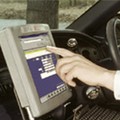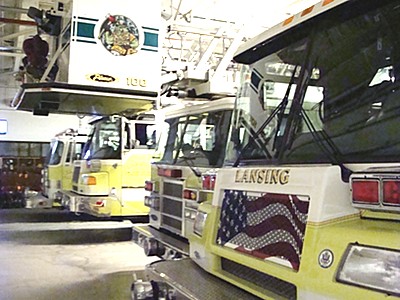- By Dan Veaner
- News
 Print
Print  Lansing Fire Commissioners unanimously approved the purchase of six mobile data systems Tuesday. The in-vehicle computers will provide more information to help responders react to emergencies faster and more appropriately. Landing fire fighter Casey Bordoni and 911 dispatcher Brian Cameron explained the benefits to a system Bordoni had scoped out.
Lansing Fire Commissioners unanimously approved the purchase of six mobile data systems Tuesday. The in-vehicle computers will provide more information to help responders react to emergencies faster and more appropriately. Landing fire fighter Casey Bordoni and 911 dispatcher Brian Cameron explained the benefits to a system Bordoni had scoped out."It's going to help with our responses to incidents large and small," Bordoni said. "It will benefit the whole community. If I have a map in front of me that shows where the call is and where I am it helps with our response a lot."
Cameron has been a 911 dispatcher for eight years. He said mobile data units provide information that will help emergency responders when they get to the scene. For example floor plans and emergency contacts for the Lansing schools can be instantly transmitted to units on their way to the scene. He laid out a scenario in which Lansing Fire Chief Scott Purcell could get the right help to a fire faster, and use floor plans and other information to go directly where responders need to be.
"Scott's there and says, 'the building's on fire'. All he's got to do is puch one button on his computer and he can see 01 and 36 is on the way, he can call Dispatch and say he needs Cayuga Heights and Locke. He can call an emergency contact and say Call (Buildings & Grounds Supervisor Glenn Fenner) - the school's on fire."
The units are 'T902 Toughbook' laptop computers with a 12 inch touch screen and keyboard, mounted next to the driver in emergency vehicles. The initial six mobile data units will be installed in the Chiefs Vehicle, the Duty Chiefs Vehicle, an EMS vehicle that responds from Central Station, an EMS Vehicle that responds from the Village station, the first engine (pumper) that responds from Central Station, and the Engine (pumper) that responds from the Village station.

The computer also provides the incident history for the site, and Cameron said because all entries are time stamped the data can be used to document incidents. The computer also has links to the Emergency Response Guidebook and current Tompkins County maps that include building footprints. Some units have GPS capability so responders can see where they are on the maps. Bordoni said that while he knows Lansing roads pretty well, he relies on maps and directions when responding in nearby communities. About half the calls in Lansing come from the Village. A new Village fire station on Oakcrest Road is currently being completed.
Bordoni said he researched the same equipment many Tompkins County emergency and law enforcement agencies use, including Ithaca Fire Department, the Tompkins County Sheriff's Office, Cornell Police, and Ithaca Police Department to insure compatibility with other local fire departments and the Tompkins County 911 system. he said he also researched an iPad-based system, but concluded the tougher laptops would last longer, standing up to vibrations in the big trucks. Mobil data cards provide Internet access for quick research incident response procedures on the scene.
"Most of the deputies have mobile data in their cars," Cameron explained. "They see their calls as they come in. They can see any comments from the dispatcher. The address is available right there. On fire units you can see what's assigned to the call, the status of those units -- whether they're en route or waiting for a crew -- floor plans and emergency contacts."
Bordoni said it could help prevent incidents like the recent tragedy in Webster, NY at which fire fighters were gunned down when they responded to a call. He said that information on whether law enforcement officials have been called to the scene, and incident report history help put together a bigger picture that will help fire fighters evaluate emergencies as they respond to them.
"We have a lot of these resources available right now," Bordoni said. "But this will bring it all into one system. It's user friendly and makes our response capabilities a lot better. We're not Cayuga Heights with two square miles. We have 75 square miles. With 1000 calls a year this is definitely going to help."
The commissioners voted to approve the purchase of six units, mounting and installation for $20,736. The systems are purchased at the state contract bid price.
v9i9
